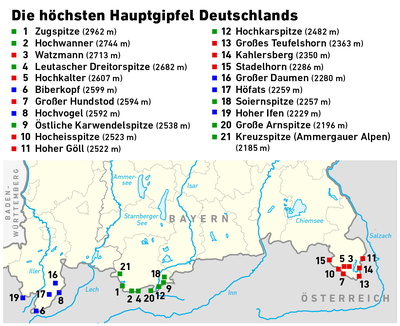
This is a list of the highest mountains in Germany. All of these mountains are located in the federal state of Bavaria. They lie within the Alps in the region known as the Eastern Alps and are part of the Northern Limestone Alps. The majority belong to the mountain ranges of the Wetterstein, Berchtesgaden Alps and Allgäu Alps.
Because the definition of a mountain is not universally agreed upon, a distinction is made between main summits and other peaks. Subsidiary summits or subpeaks are not counted. In the Alps a summit is classed as independent, according to the UIAA definition, if it has a prominence of 30 metres (98 ft) or more. In order for a peak to qualify as an independent mountain, however, it must have a prominence of at least 300 metres (980 ft).[1] Based on this definition only the main summits of entire mountain massifs are counted. All elevations with a prominence below 30 metres (98 ft) are considered as subpeaks.[2]
By these definitions, the highest mountains in Germany are the Zugspitze (2,962 m or 9,718 ft), Hochwanner (2,746 m or 9,009 ft) and Watzmann (Middle Peak, 2,713 m or 8,901 ft). If all independent summits are counted, the Zugspitze is followed by the Schneefernerkopf (2,875 m or 9,432 ft) and the Middle Wetterspitze (2,747 m or 9,012 ft) in places two and three. Both are however, part of the Zugspitze massif and lie relatively close to the summit of the Zugspitze itself.
The highest mountain which lies entirely on German soil is the Watzmann with a height of 2,713 metres (8,901 ft), followed by the Hochkalter (2,607 m or 8,553 ft), the Großer Daumen (2,280 m or 7,480 ft) and the Höfats (2,259 m or 7,411 ft). Likewise fully on German territory, but considerably less independent, are the Middle Höllentalspitze (2,742 m) and the Hochblassen (2,703 m).
A majority of the summits were verifiably climbed in the 19th century; the Watzmann and Hoher Göll for example as early as 1800. The Zugspitze was officially climbed for the first time in 1820. However, there are many peaks of which it is suspected had been climbed in earlier times by unknown climbers.
Because the borders of Germany have often changed during the course of the centuries, there were different "highest mountains" in the past. For example, during the time of the Holy Roman Empire up to 1806, the Ortler in present-day South Tyrol, at 3,905 m (12,812 ft), was the highest German mountain. During the colonial period to 1918 Mount Kilimanjaro in the colony of German East Africa, at 5,895 m (19,341 ft), was officially the highest mountain of the German Reich. During the Nazi era from 1938 to 1945 this title went to the Großglockner which, at 3,797 m (12,457 ft), is today the highest mountain in Austria.
- ^ Or a prominence of 100m according to other authorities.
- ^ "The Viertausender of the Alpen – Offizielles UIAA-Verzeichnis" (PDF) (in German). UIAA. March 1994. Retrieved 7 May 2009.